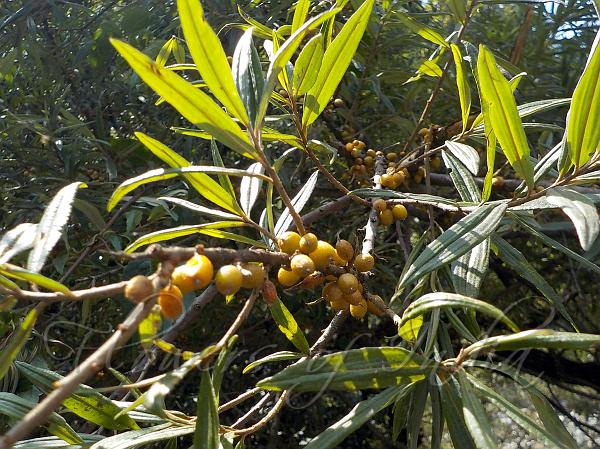|
| Willow-Leaved Sea Buckthorn |
|

|

| File size | 1017334 |
| Original date | 9/30/14 12:22 PM |
| Resolution | 2048 x 1536 |
| Flash | Flash did not fire, auto |
| Focal length | 4.1mm |
| Exposure time | 1/500s |
| Aperture | 3.3 |
| Focus Distance | |
| Metering Mode | Multi-segment |
| Camera make | NIKON |
| Camera model | COOLPIX S32 |
| Sensor type |
|
|
|
|
Photo: |
Botanical name: Hippophae salicifolia Family: Elaeagnaceae (Silverberry family)
Synonyms: Hippophae rhamnoides subsp. salicifolia
Synonyms: Hippophae rhamnoides subsp. salicifolia
Willow-Leaved Sea Buckthorn is a small deciduous
shrub or small tree reaching 2-7 m in height, with a narrow canopy and
a well developed root system. Trunk is up to more than 30 cm in
diamter. Leaf-stalks are 2-3 mm, leaves whitish below with usually
reddish brown midrib, above green, linear-oblong, 4.2-6.2 x 0.6-1.2 cm,
velvety below, hairy above, margin usually curled. Male flowers are
2.5-3 mm, anthers 2-2.5 mm. Female calyx about 2 mm. Peduncle 1-4 mm.
Fruit orange-yellow to greenish brown or yellow to deep red, globose,
terete, 5-7 × 5-7 mm. Endocarp is easy to separate from seed. Seed
broadly ellipsoid to ovoid, flattened, 2.8-5.2 mm. The fruit is edible,
rich in vitamins, often made into jam and has medicinal properties.
This sea buckthorn can be be found in the Himalayas at elevations of
2000-3700 m. Flowering: June.
Medicinal uses: The tender branches and leaves
contain bio-active substances which are used to produce an oil that is
quite distinct from the oil produced from the fruit. This oil is used
as an ointment for treating burns. A high-quality medicinal oil is made
from the fruit and used in the treatment of cardiac disorders, it is
also said to be particularly effective when applied to the skin to heal
burns, eczema and radiation injury, and is taken internally in the
treatment of stomach and intestinal diseases.
The tender branches and leaves
contain bio-active substances which are used to produce an oil that is
quite distinct from the oil produced from the fruit. This oil is used
as an ointment for treating burns. A high-quality medicinal oil is made
from the fruit and used in the treatment of cardiac disorders, it is
also said to be particularly effective when applied to the skin to heal
burns, eczema and radiation injury, and is taken internally in the
treatment of stomach and intestinal diseases.
Medicinal uses:
 The tender branches and leaves
contain bio-active substances which are used to produce an oil that is
quite distinct from the oil produced from the fruit. This oil is used
as an ointment for treating burns. A high-quality medicinal oil is made
from the fruit and used in the treatment of cardiac disorders, it is
also said to be particularly effective when applied to the skin to heal
burns, eczema and radiation injury, and is taken internally in the
treatment of stomach and intestinal diseases.
The tender branches and leaves
contain bio-active substances which are used to produce an oil that is
quite distinct from the oil produced from the fruit. This oil is used
as an ointment for treating burns. A high-quality medicinal oil is made
from the fruit and used in the treatment of cardiac disorders, it is
also said to be particularly effective when applied to the skin to heal
burns, eczema and radiation injury, and is taken internally in the
treatment of stomach and intestinal diseases. | Identification credit: Prashant Awale | Photographed in the Great Hinalayan National Park, HImachal Pradesh. |
• Is this flower misidentified? If yes,